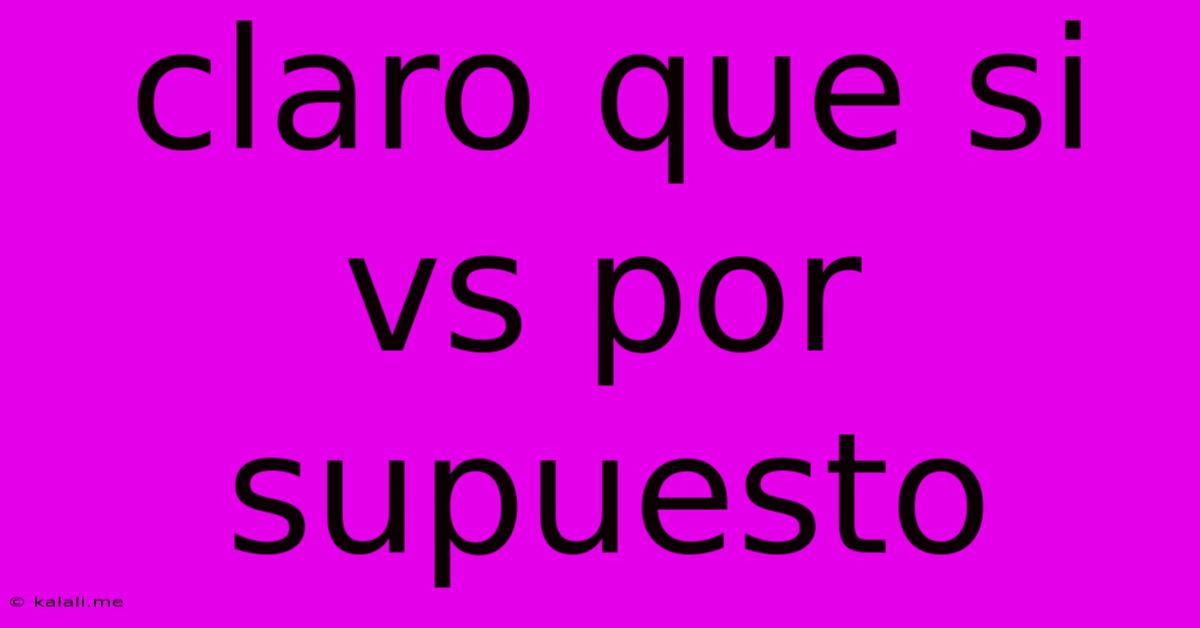Claro Que Si Vs Por Supuesto
Kalali
Jun 02, 2025 · 2 min read

Table of Contents
Claro Que Sí vs. Por Supuesto: Understanding the Nuances of Spanish Agreement
Choosing between "claro que sí" and "por supuesto" in Spanish can feel tricky, even for intermediate learners. Both phrases translate to "of course" or "certainly" in English, but their subtle differences in connotation and usage can significantly impact your communication. This article delves into the nuances of each expression, helping you confidently select the most appropriate phrase in any context.
Meta Description: Learn the subtle differences between "claro que sí" and "por supuesto" in Spanish. This guide clarifies their usage, connotations, and helps you choose the right phrase for every situation.
Understanding "Claro Que Sí"
"Claro que sí" literally translates to "clear that yes." It's a more emphatic and enthusiastic affirmation than "por supuesto." The inclusion of "que sí" adds a layer of explicit agreement, highlighting your positive and often joyful response.
- Connotation: Friendly, enthusiastic, affirmative, sometimes playful.
- Usage: Ideal for informal settings with close friends and family. It conveys warmth and a strong sense of agreement. Think of situations where you're excited to help or readily agree to a request.
- Example: "¿Me ayudas con la mudanza?" (Can you help me move?) "Claro que sí! ¡Con gusto!" (Of course! With pleasure!)
Understanding "Por Supuesto"
"Por supuesto" translates literally to "for the supposed" or more naturally "of course." It's a more formal and neutral expression of agreement. While it still signifies affirmation, it lacks the enthusiastic tone of "claro que sí."
- Connotation: Formal, polite, neutral, straightforward.
- Usage: Suitable for formal settings, professional interactions, and situations where a simple, polite affirmation is required. It avoids the potential for informality or over-enthusiasm.
- Example: "¿Puedo usar su teléfono?" (May I use your phone?) "Por supuesto." (Of course.)
Key Differences Summarized:
| Feature | Claro Que Sí | Por Supuesto |
|---|---|---|
| Formality | Informal | Formal |
| Tone | Enthusiastic, friendly, playful | Neutral, polite, straightforward |
| Emphasis | Stronger affirmation | More subtle affirmation |
| Appropriate Use | Close friends, family, informal settings | Professional settings, formal interactions |
When to Use Each Phrase:
Choosing between "claro que sí" and "por supuesto" depends heavily on the context and your relationship with the person you're speaking to. Consider the following:
- Informal Conversations: Opt for "claro que sí" to convey enthusiasm and friendliness.
- Formal Situations: "Por supuesto" is the safer and more appropriate choice.
- Requests for Help: "Claro que sí" expresses willingness and eagerness to assist.
- Simple Agreements: "Por supuesto" suffices as a polite and concise confirmation.
Mastering the Nuances
While both phrases express agreement, understanding their subtle differences allows for more nuanced and effective communication in Spanish. By paying attention to the context and your desired level of formality and enthusiasm, you can confidently choose between "claro que sí" and "por supuesto" and elevate your Spanish fluency. Practice using both phrases in different contexts to solidify your understanding and improve your overall conversational skills. Remember, context is key!
Latest Posts
Latest Posts
-
Do You Need Flux To Solder
Jun 04, 2025
-
Malformed Entry 1 In Sources File Etc Apt Sources List D Third Party Sources
Jun 04, 2025
-
Fallout New Vegas Ncr Join Yes Man
Jun 04, 2025
-
Mulitple 3 Displays Only Shows 2 Mac
Jun 04, 2025
-
How Does Light Get Through Glass Does The Frequency Change
Jun 04, 2025
Related Post
Thank you for visiting our website which covers about Claro Que Si Vs Por Supuesto . We hope the information provided has been useful to you. Feel free to contact us if you have any questions or need further assistance. See you next time and don't miss to bookmark.